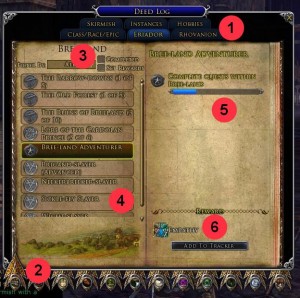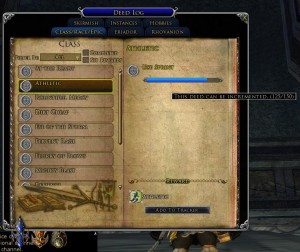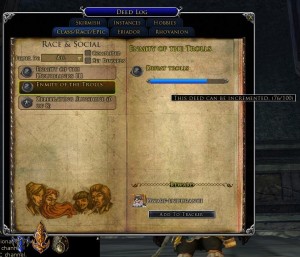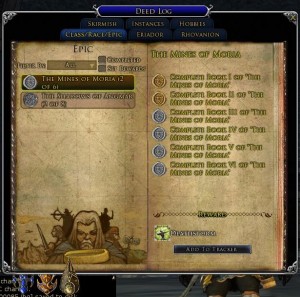This is part two of a series of posts about the Trait system in the MMO game – Lord of the Rings Online. The series started with this post. This time, I’ll be focussing on the Deed system in the game since most of the methods of earning Traits rely on it.
Introduction
There are two main mechanisms for tracking progress on activities in Lord of the Rings online. They are the quest tracker and the deed system. The quest tracker is where most of the XP earning activity of your character is focussed, while the deed system covers the other stuff. That other stuff includes titles and traits, and sometimes reputation or items.
The key difference between quests and deeds is that starting a quest involves finding someone who needs you to do something (for the most part), while starting deeds tends to be more accidental and passive.
What are Deeds
Deeds are actions your character has completed which are either more general in nature or more epic in nature than a single quest. For example, a single quest may have you trying to locate a lost fortress, while a deed might encompass finding all the fortresses in a particular area. Deeds are things that people hear about, things that bring you renown and hence lead to titles or changes to your character to reflect the journey that they have undertaken.
When others hear that you have vanquished 200 orcs in the Lonelands you will find them calling you by a title, or if you find yourself favouring a particular attack you may find that attack becomes both more efficient and more deadly, by completing 60 quests in the Shire you might find you’ve joined the Bounders in the defence of their land, etc.
Starting a deed is a passive activity. They are started when you complete the first step in them, even if you don’t know what that step is. When you kill your first Goblin in the Breelands you might find you’ve been given a new deed to kill 50 of them, or when you find your first lost fortress in the North Downs you are given a deed to find them all, or even using a particular skill presents a learning opportunity and using that skill another 900 times brings you some insight and more deadly force. You’ll see some text pop up on the screen, and an icon in the notification area telling you that you’ve been assigned a new deed. Clicking the icon opens the deed window (see below) which gives more details about what you need to achieve.
One of the complications is that deeds are sometimes level linked. Completing an activity at level 5 won’t give you the deed, but the same thing at level 15 might. This is particularly true for deeds that result in Class, Racial and Legendary traits. In the first 20 or so levels, you’ll find you build up a lot of potential deeds, and complete few of them. As you gain levels you’ll get time to go back and complete those deeds to round out your character, while earning new deeds from new locations further on.
Some of the more common deeds are,
- Kill deeds – you must kill a certain number of a particular creature in a specific area. The basic deed tends to give you a title, and the advanced deed (started when you complete the basic one) tends to give you a Virtue trait.
- Scout deeds – finding locations, objects, buildings or people. Rewards vary, and sometimes include traits.
- Quest deeds – completing a series of specific quests, or completing a total number of quests in an area. These often lead to traits or reputation rewards (or more esoteric rewards, such as being able to swift travel to that location by horse).
- Collection deeds – finding and collecting particular items.
- Skill deeds – using the same skill many times. These always reward you with a Class trait, they are usually level restricted so using a skill at level 38 might not trigger the deed, while the same skill at 40 might.
- Enmity Kill deeds – rather than killing creatures in a particular area, these deeds require a character to kill a specific type of creature anywhere and lead to Race traits. The deeds come in several ranks, and are all level restricted.
The Deed Window
Deeds are managed through the deed window, which can be opened using shift + L. The deed window is a complex beast and it’s easy to miss stuff. Here’s how it looks.
The numbered areas are,
- At the top of the window (new look with the release of Mirkwood) you can choose tabs for different areas of the game or different types of deeds.
- At the very bottom, and the bit most often missed, are tabs which select a sub-area or type based on the selection chosen at #1. For example, the deed window above has Eriador as the area, and each of the tabs in #2 are for the different locations, such as The Shire, or North Downs.
- Here you can filter what is shown in the window, the key option is the ‘Completed’ checkbox. When ticked it shows only completed deeds, when unticked it shows only uncompleted deeds.
- This side of the window shows all the deeds which match the type (#1), area (#2) and filter (#3).
- This shows the progress for the chosen deed. It may be a bar such as in this example, or a list of tasks (in a later example).
- And finally, the rewards for completing the deed are listed in this area, you may find a small vertical scroll-bar if there are more than one reward. Rewards may be traits (as in this case, a virtue), or reputation, an item, or sometimes combinations of rewards.
It’s easy to open the deed window and forget the tabs around #2, or open the window and forget you’re looking at completed deeds not ones you still need to finish.
Deed progress is measured in different ways, depending on the deed in question. Here we can see a deed which results in a Class trait (and so is progressed by using a skill over and over again).
Hovering the mouse over the blue bar shows the progress. When the bar turns yellow, it means you may no longer progress this deed any further on this day. Class skill based deeds usually require the enemy they are used against to provide XP (i.e. no slaughtering hundreds of grey enemies) and so have a high daily limit. However, some class skills aren’t combat related (such as buffs, or summoning pets) and so have a much smaller daily use limit (maybe as low as 5 per day).
Here we see a deed which requires killing a certain type of creature to progress.
And here we see a deed which has a number of discrete steps which must be completed.
How they link to Traits
Deeds and traits go hand-in-hand because the vast majority of traits are earned by completing deeds (not all deeds give traits, but nearly all traits are given by deeds). In the examples above we can see in the rewards the following traits,
- The virtue Empathy in the first image, where the character already has 6 ranks so earning it will provide the 7th.
- The class trait Athletic in the second image, which will modify how a particular skill for that character works.
- The race trait Dwarf-Endurance in the third image.
- Another class trait Deathstorm in the final image.
Summary
If quests are the Fairy Cake of Lord of the Rings online then deeds are the Pink Icing. Deeds provide many rewards including titles and swift travel options, but most importantly they provide traits. It is common to complete all the quests in an area before completing all the deeds and you need to decide whether to move on and complete the deeds later, or stay longer and complete the deeds there and then. There is no right answer. Skill based deeds take a long time to progress and if you don’t actively work on them, you’re likely to never complete some of them.
In the third article, I’ll focus on Virtues.




